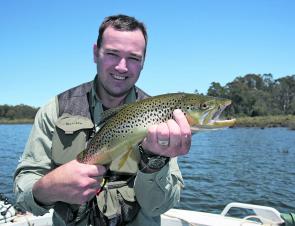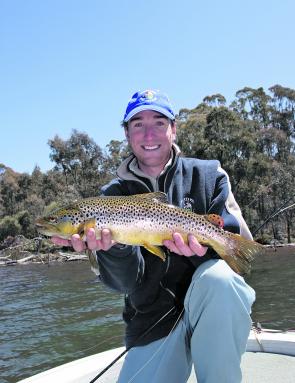This is the first in a series of basic technique articles on trout. So why trout? Because trout are arguably the most popular freshwater species in Victoria and Tasmania.
There are two main species of trout: brown trout and rainbow trout. There are other species stocked in Australian waters such as brook trout and Atlantic salmon (with small liberations of Chinook salmon in Victoria). Mostly though, trout encountered will be either brown or rainbow.
Introduced into Tasmania from England in 1864, brown trout have spread to just about every state in Australia, and have self-sustaining populations in Tasmania, Victoria, NSW, South Australia and Western Australia.
Rainbow trout were introduced much later and have now extended their reach almost as far as brown trout. Rainbow trout tend to suit hatchery management better, and as a result most stocking of trout will be rainbow trout.
Many state fisheries organisations/departments regularly stock trout into waterways close to population centres and in waters that lack spawning flows, and the Victorian and Tasmanian fisheries departments are generally very good at keeping stocks up to good angling levels in accessible places.
The reason for the popularity of trout is as diverse as the locations you find them in. Generally speaking trout can be successfully targeted with bait, lures and artificial flies. They can be targeted all year, from the depths of winter to the middle of summer.
Trout fight hard, eat well and are often found in the most beautiful of places. There are very few more idyllic fishing scenes than fishing in a mountain stream or small highland lake.
There are a huge range of things that trout eat, and this makes it easy to target them. While trout can often be easy to catch, they can also be the most difficult fish of all – often on the same day.
Tackle for trout is reasonably straightforward and unless you love accumulating lots of tackle (and who doesn’t love that) your basic 6-7’ 2-4kg spin outfit with a 2000-2500 series reel will suit most trout likely to be encountered.
Lure fishers should spool up with 2kg braid and use a long 2-3m fluorocarbon leader of 2-3kg. Bait fishers might like a longer rod depending upon the type of bait and kind of water. Flicking grasshoppers upstream will need a longer rod and a shorter rod will suit fishing static worms in a lake.
Perhaps the pinnacle of trout fishing is flyfishing. Flyfishing basically evolved as the ‘proper’ method for targeting trout in the genteel days of old England. These days it is a cutting edge method for presenting close imitations of what the trout are feeding on.
Flyfishing for trout is a whole industry in itself and is certainly the most written about branch of fishing, let alone trout fishing. Most beginning fly fishers are best suited to a medium action 9’ fly rod with a floating line.
As with all tackle, the best advice is from your local specialist tackle dealer – prices might be cheaper on line, but good local and face-to-face advice is priceless.
Trout will live in freshwater that is mostly below 17ºC, well oxygenated and relatively clean. This means lakes and streams; in fact any trickle that flows consistently will hold trout.
Trout spawn in running water during the late autumn/winter months. Lakes without inflowing streams that hold good water flows between March and October will generally struggle to hold good self-sustaining populations.
Where rivers have an unimpeded flow to the sea, trout will adapt to estuary conditions very easily and grow to huge proportions. Termed ‘searunners’, the best of these fish migrate to the estuary mouth each year to feed upon the baitfish accumulations. These fish are often bright silver and fight harder than many comparable-sized saltwater species.
Streams are where most beginning trout fishers encounter their first trout. The best streams are those that flow from high country with consistent rainfall. In spring and autumn these flows should be quite strong while they will ease back during summer.
The best locations to find streams like these is in the north east of Victoria and pretty much anywhere in Tasmania. Streams flowing into Lake Eildon in Victoria are great places to start, and while they may be busy at different times, walk far enough and you will find some peace and quiet.
If lakes are more to your liking or closer to home, there are plenty of options to the east and west of Melbourne. The lakes around Camperdown such as lakes Purrumbete and Bullen Merri are well known for their big fish and good fishing, while others such as Lake Bolac are also highly regarded for big fish.
Tasmania has thousands of lakes on the central plateau and most new trout fishers are well served at lakes like Arthurs.
A good friend of mine once said that trout feed on brown things that are 10mm long. While this may seem an over-simplification, in essence it is true. In streams, trout feed mostly on aquatic insect larvae like stick caddis, mayfly nymphs, small shrimp and things washed in from the banks, like worms and grubs. Terrestrial bugs like beetles, ants and grasshoppers are a huge part of trout diet during the warmer months.
In lakes we can add bait fish, like smelt or galaxia (depending upon location), dragonfly larvae (mudeyes), damselfly larvae, scud (a bottom dwelling crustacean), and yabbies. Again wind-blown terrestrial insects like ‘hoppers and beetles are a huge part of a varied trout diet.
Trout will feed on the surface whenever sufficient food is present. Mostly though they will feed either on the bottom or in the mid levels of the water. Trout are like all wild creatures, they follow two basic principles – food and shelter. If you can find plenty of trout food near areas that give shelter, then you will find plenty of trout.
Trout fishing is very much about fishing the percentages – generally trout feed on the bottom on slow moving small things, with the odd fast moving thing. If the aim is catch a trout, then bait fishing is the most productive method. In the next instalment, more about fishing bait in streams and lakes.
Reads: 5181
A prime rainbow trout taken near Ballarat to the west of Melbourne.

Brown trout are found pretty much everywhere and fall to any method.

Wild brown trout are the prime target for many experienced anglers.

Lure fishing for trout is an exciting and productive method.




